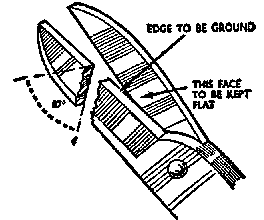
Straight and Bent Snips. Thin sheet metal can be cut to shape quickly with hand shears or snips. These can be either straight or curved, as in Fig. 1. Straight snips are used for cutting a straight line and for curves having a large radius. Bent snips are used in cutting small curves.

When cutting external curves with the curved shears, the shears should be held so that the curve of the blades is opposite to that of the cutting line on the metal. In working with hand snips on heavy gauge metal, the work can be done more, easily if one arm of the snips is gripped in the vise so that greater force can be applied to the other arm. Another plan is to insert a short length of pipe over the free, handle to increase the leverage, but this is likely to damage the shears. If a piece of metal cannot be cut easily with shears, it is best to use some other method of cutting, such as a hacksaw or shearing machine.

In sheet metal work, the ends of cylindrical or conical shaped jobs are best trimmed, when this is necessary, by using curved shears. The line to be followed is marked on the inside, and the shears and work held as shown in Fig. 2.
The jaws of most shears are pivoted about a rivet and if they need sharpening, it is difficult to regrind them separatively without first drilling out the rivet. Unless they have become very badly damaged this is seldom done; the jaws are opened as wide as possible and the edges of the jaws reground, preferably on a wet grindstone.
The edge is made at an angle of about 87 degrees, as shown in Fig. 3. and the burr taken off the face. Take care not to grind any metal off the face itself.
If any space is left between the two jaws, the snips will not cut thin metal, particularly near the edge of a sheet. The rivet must then be tightened slightly with a rivet set and a hammer. Be careful not to tighten the rivet too much, or the shears will be hard to work. A good test for shears is to see whether they will cut cleanly a thin sheet of paper; they will do so if they have been accurately ground and set.